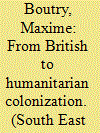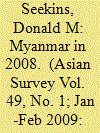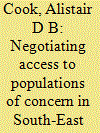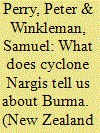|
|
|
Sort Order |
|
|
|
Items / Page
|
|
|
|
|
|
|
| Srl | Item |
| 1 |
ID:
105369


|
|
|
|
|
| Publication |
2011.
|
| Summary/Abstract |
Developed and developing nations alike face low-probability but high-consequence exogenous shocks, including ice storms, chemical spills, terrorist attacks, and regional blackouts. Recently, "natural" disasters have dominated the airwaves; mega-catastrophes that claim more than 1,000 lives have become an almost yearly occurrence. In 2010, the Haiti and Chile earthquakes killed more than 200,000 people between them and felt all too familiar to many observers in the West. Before them were Cyclone Nargis in Burma, which took 130,000 lives in 2008; Hurricane Katrina, which killed more than 1,500 New Orleans residents and left 80% of the city flooded in 2005; and the Indian Ocean tsunami, which claimed roughly a quarter of a million lives in India, Indonesia, Sri Lanka, and Thailand in 2004.
|
|
|
|
|
|
|
|
|
|
|
|
|
|
|
|
| 2 |
ID:
128882


|
|
|
|
|
| Publication |
2013.
|
| Summary/Abstract |
The humanitarian response to the disaster caused by Cyclone Nargis that hit the Ayeyarwady Delta region of Myanmar in 2008 is a pertinent example of a very specific phase in humanitarian response at the transition between emergency and development. The author shows that this phase, known as 'early recovery', being built on the specific characteristics of the emergency (lack of time and lack of means and input) and oriented towards development, is one in which the humanitarian aid agency is relatively restricted to the humanitarian sphere itself. As a result, the ideological discourse lengthily denounced by the post-structuralist anthropology of development - as a set of Western values imposed on the 'developing' countries to assert a new form of dominion - is actually powerful and quasi-monolithic in shaping the consequences of humanitarian aid. While there is no 'arena' for the 'beneficiaries' to discuss the aid's agency, a 'methodological populism' approach reveals, on the one hand, the antagonisms between a humanitarian ideology conveying considerations such as 'horizontal' communities versus 'hierarchical bonds' and, on the other, the similarity of its socioeconomic consequences on the Delta's society to those of the British colonial period.
|
|
|
|
|
|
|
|
|
|
|
|
|
|
|
|
| 3 |
ID:
086692


|
|
|
|
|
| Publication |
2009.
|
| Summary/Abstract |
Cyclone Nargis struck Burma's Irrawaddy Delta on May 2-3, 2008, and claimed as many as 140,000 victims, the largest natural disaster in the country's history. However, the State Peace and Development Council proceeded with a referendum on a new constitution on May 10 and 24, which it claimed was approved by an overwhelming majority of voters.
|
|
|
|
|
|
|
|
|
|
|
|
|
|
|
|
| 4 |
ID:
158637


|
|
|
|
|
| Summary/Abstract |
South-East Asia is home to both conflict and ‘natural’ disasters which have caused significant displaced populations. Given this context, there is a need to better understand the motivations of the multiple actors involved in negotiating humanitarian responses, and to account for the impact the finished agreement has on the region both in the short and long terms. This article investigates the motivations behind two humanitarian responses in South-East Asia. The first case is the set of humanitarian responses to the Indochinese exodus in the 1970s and 1980s. The second case is the humanitarian response to those affected by Cyclone Nargis in Myanmar during the late 2000s and early 2010. Both of these agreements have been held up as historic and ground breaking achievements within the international relations of South-East Asia. This article assesses these agreements to identify the multiple levels of governance involved and the individual actors’ motivations behind them. It argues that greater appreciation of these dynamics will contribute to understanding the governance of humanitarian responses to populations of concern in South-East Asia. This will be important to consider as new crises emerge that demand new negotiations within a crowded field of actors governing humanitarian responses in the region.
|
|
|
|
|
|
|
|
|
|
|
|
|
|
|
|
| 5 |
ID:
089806


|
|
|
|
|
| Publication |
2009.
|
| Summary/Abstract |
Cyclone Nargis of 2-3 May 2008 devastated south-west Burma. Two major reports on the subsequent relief operations present different pictues.
|
|
|
|
|
|
|
|
|
|
|
|
|
|
|
|
|
|
|
|
|